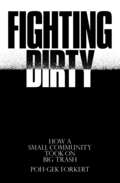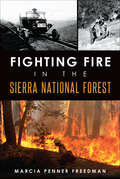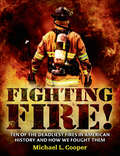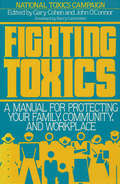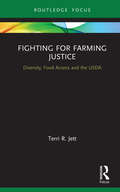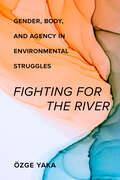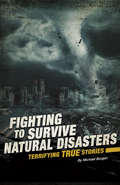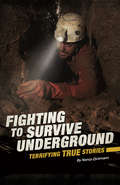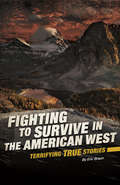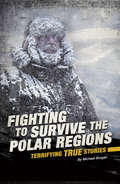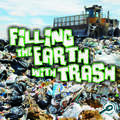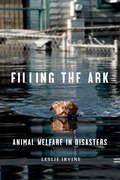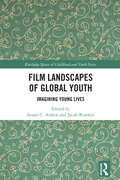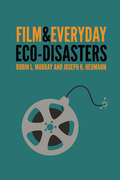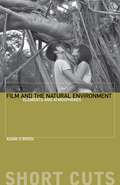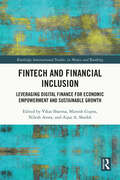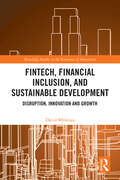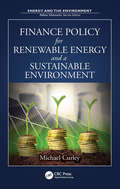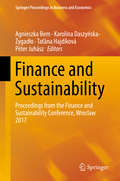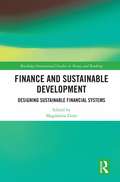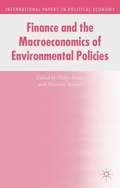- Table View
- List View
Fighting Dirty: How a Small Community Took on Big Trash
by Poh-Gek ForkertFighting Dirty tells the story of how one small group of farmers, small-town residents, and Indigenous people fought the world’s largest waste disposal company to stop them from expanding a local dumpsite into a massive landfill. As one of the experts brought in to assess the impact the toxic waste would have on the community, Poh-Gek Forkert was part of the adventures and misadventures of their decades-long fight.
Fighting Fire in the Sierra National Forest
by Marcia Penner FreedmanTo live in the foothills on the periphery of the Sierra National Forest is to live with the certainty of summer wildfires. Each year, from April forward, Californians watch the sky and sniff the air for telltale signs of smoke. While fire remains a constant threat, the strategy for combating it has evolved with the understanding of its beneficial role in the forest environment. Marcia Penner Freedman traces the history of firefighting and fire management from the forest's early years through the policy shifts that began in the 1960s and the measures used today.
Fighting Fire!: Ten of the Deadliest Fires in American History and How We Fought Them
by Michael L. CooperFrom colonial times to the modern day, two things have remained constant in American history: the destructive power of fires and the bravery of those who fight them.Fighting Fire! brings to life ten of the deadliest infernos this nation has ever endured: the great fires of Boston, New York, Chicago, Baltimore, and San Francisco, the disasters of the Triangle Shirtwaist Factory, the General Slocum, and the Cocoanut Grove nightclub, the wildfire of Witch Creek in San Diego County, and the catastrophe of 9/11. Each blaze led to new firefighting techniques and technologies, yet the struggle against fires continues to this day. With historical images and a fast-paced text, this is both an exciting look at firefighting history and a celebration of the human spirit.
Fighting Toxics: A Manual for Protecting your Family, Community, and Workplace
by John O'Connor Barry Commoner Gary Cohen Barry National Toxics CampaignFighting Toxics is a step-by-step guide illustrating how to investigate the toxic hazards that may exist in your community, how to determine the risks they pose to your health, and how to launch an effective campaign to eliminate them.
Fighting for Farming Justice: Diversity, Food Access and the USDA (Earthscan Food and Agriculture)
by Terri R. JettThis book provides a detailed discussion of four class-action discrimination cases that have recently been settled within the United States Department of Agriculture (USDA) and have led to a change in the way in which the USDA supports farmers from diverse backgrounds. These settlements shed light on why access to successful farming has been so often limited to white men and/or families, and significantly this has led to a change for opportunities in the way the USDA supports famers from diverse backgrounds. With chapters focusing on each settlement Jett provides an overview of the USDA before diving into a closer discussion of the four key settlements, involving African American farmers (Pigford), Native Americans (Keepseagle), Woman famers (Love) and Latino(a) farmers (Garcia), and the similarities between each. This title places and emphasis on what is happening in farming culture today, drawing connections between these four settlements and the increasing attention on urban farming, community gardens, farmers markets, organic farming and the slow food movement, through to the larger issues of food justice and access to food. Fighting for Farming Justice will be of interest to scholars of food justice and the farming arena, as well as those in the fields of Agricultural Economics, Civil Rights Law and Ethic Studies.
Fighting for Love in the Century of Extinction: How Passion and Politics Can Stop Global Warming
by Eban GoodsteinThe central idea in Fighting for Love in the Century of Extinction is simple: Unchecked, global warming threatens to destroy one of every two animals, birds, plants, reptiles, forests, fish and other creatures alive today on the earth. This looming ecological collapse will only be arrested if we can articulate and embrace what the natural world means to each of us, and then fight a series of hard political battles to preserve creation. On a subject about which it is easy to feel despair, Goodstein offers a realistic, ambitious, and hopeful political solution to avoid a century of mass extinction, a vision grounded in a moral view that embraces the interconnection of all life forms on the planet. Emerging from his work as both an economist and a leader in the clean energy movement, this passionate book sets a new frame for helping Americans understand global warming as the challenge of our generation. Weaving personal narrative with scientific facts, Goodstein begins with an overview of the current global warming crisis. In Chapters 2 and 3 ("Wealth" and "Knowledge") he explores the question of whether the scale of mass extinction we are beginning to witness in the 21st century has more ominous implications for human welfare than it did in the 20th century. By destroying so much of creation,will we destroy the foundation of our own material prosperity? By tearing out so many pages in the book of life, are we depriving future generations of a vast store of knowledge? In "Spirit," he stresses the need to re-spiritualize the way we talk about the natural world. Without an effective moral language that reflects our deeply felt love of nature and its diversity, effective political action is impossible. "Politics" argues that if we are to hold global heating to the manageable, low end, Americans must stabilize emissions of global warming pollutants and begin to invest tens of billions of dollars every year in clean-energy technology solutions for the future. Stabilizing the climate requires strong leadership from the federal government --we must elect clean-energy leaders into the Senate, the House, and the Oval Office in the next few years. How to do this, by becoming involved in electoral politics, is the subject of the final chapter, "Solutions."
Fighting for the River: Gender, Body, and Agency in Environmental Struggles
by Özge YakaFighting for the River portrays women's intimate, embodied relationships with river waters and explores how those relationships embolden local communities' resistance to private run-of-the-river hydroelectric power plants in Turkey. Building on extensive ethnographic research, Özge Yaka develops a body-centered, phenomenological approach to women's environmental activism and combines it with a relational ontological perspective. In this way, the book pushes beyond the "natural resources" frame to demonstrate how our corporeal connection to nonhuman entities is constitutive of our more-than-human lifeworld. Fighting for the River takes the human body as a starting point to explore the connection between lived experience and nonhuman environments, treating bodily senses and affects as the media of more-than-human connectivity and political agency. Analyzing local environmental struggles as struggles for coexistence, Yaka frames human-nonhuman relationality as a matter of socio-ecological justice.
Fighting to Survive Natural Disasters: Terrifying True Stories (Fighting to Survive)
by Michael BurganA raging wildfire burns thousands of homes. A violent earthquake creates a giant tsunami that destroys countless lives. A giant tornado wipes a small town off the map. Discover the true stories of people who survived these terrible disasters and lived to tell the tale in this book from the Fighting to Survive series.
Fighting to Survive Underground: Terrifying True Stories (Fighting to Survive)
by Nancy DickmannWhether it's being lost in a cave or caught in a collapsed mine, being trapped underground can be terrifying. You may be cold, wet, hungry, and stuck in absolute darkness. Even worse is not knowing if anyone will ever find you. Find out how people survived their ordeal in these true stories of those who were trapped underground in this book from the Fighting to Survive series.
Fighting to Survive in the American West: Terrifying True Stories (Fighting to Survive)
by Eric BraunLife on the American frontier wasn't easy. Pioneers had to deal with tough challenges including rough terrain, extreme weather, starvation, and dangerous animals. But in spite of the hardships, people persevered. Follow the true stories of those who braved the frontier and what they had to do to survive in this book from the Fighting to Survive series.
Fighting to Survive the Polar Regions: Terrifying True Stories (Fighting to Survive)
by Michael BurganImagine being lost near the North or South poles. All around you is nothing but snow and ice as far as you can see. What would you do? Discover the true tales of daring people who survived through bitter cold, deadly storms, and other dangers with little food or other resources in this book from the Fighting to Survive series.
Filling The Earth With Trash (Green Earth Science Discovery Library)
by Jeanne SturmYoung Readers Will Discover What Happens To Trash In A Landfill.
Filling the Ark: Animal Welfare in Disasters (Animals and Ethics)
by Leslie IrvineWhen disasters strike, people are not the only victims. Hurricane Katrina raised public attention about how disasters affect dogs, cats, and other animals considered members of the human family. In this short but powerful book, noted sociologist Leslie Irvine goes beyond Katrina to examine how disasters like oil spills, fires, and other calamities affect various animal populations—on factory farms, in research facilities, and in the wild. Filling the Arkargues that humans cause most of the risks faced by animals and urges for better decisions about the treatment of animals in disasters. Furthermore, it makes a broad appeal for the ethical necessity of better planning to keep animals out of jeopardy. Irvine not only offers policy recommendations and practical advice for evacuating animals, she also makes a strong case for rethinking our use of animals, suggesting ways to create more secure conditions. The hopeful message of Filling the Ark is that once we realize how we make animals vulnerable to disasters we can begin to question and change the practices that put them at risk. This book will make a significant contribution to the field of animals and society and to the literature on animal welfare.
Film Landscapes of Global Youth: Imagining Young Lives (Routledge Spaces of Childhood and Youth Series)
by Stuart C. Aitken Jacob RowlettThis book explores the dynamic landscapes of global youth through spatially grounded chapters focused on film and media. It is a collection of incredible works concerning children and young people in, out, and through media as well as an examination of what is possible for the future of research within the intersections of geography, film theory, and children’s studies.It contains contributions from leading academics from anthropology, sociology, philosophy, art, film and media studies, women and gender studies, Indigenous studies, education, and geography, with chapters focused on a spatial area and the representations and relationships of children in that area through film and media. The insights presented also provide a unique and eclectic perspective on the current state of children’s research in relation to the ever-changing media landscape of the 21st century. Film Landscapes of Global Youth approaches the subjects of children and young people in film and media in a way that is not bound by genre, format, medium, or the on-/off-screen binary. Each chapter offers an insightful look at the relationships and portrayals of children and young people in relation to a specific country, culture, or geographic feature.This book is a must-read for anyone interested in the intersections between geography, young lives, and the power of film, television, social media, content creation, and more.
Film and Everyday Eco-disasters
by Robin L. Murray Joseph K. HeumannEco-disasters such as coal-mining accidents, oil spills, and food-borne diseases appear regularly in the news, making them seem nearly commonplace. These ecological crises highlight the continual tensions between human needs and the environmental impact these needs produce. Contemporary documentaries and feature films explore environmental-human conflicts by depicting the consequences of our overconsumption and dependence on nonrenewable energy.Film and Everyday Eco-disasters examines changing perspectives toward everyday eco-disasters as reflected in the work of filmmakers from the silent era forward, with an emphasis on recent films such as Dead Ahead, an HBO dramatization of the Exxon Valdez disaster; Total Recall, a science fiction action film highlighting oxygen as a commodity; The Devil Wears Prada, a comment on the fashion industry; and Food, Inc., a documentary interrogation of the food industry. The authors evaluate not only the success of these films as rhetorical arguments but also their rhetorical strategies. This interdisciplinary approach to film studies fuses cultural, economic, and literary critiques in articulating an approach to ecology that points to sustainable development as an alternative to resource exploitations and their associated everyday eco-disasters.
Film and Place in an Intercultural Perspective: India-Europe Film Connections
by Krzysztof Stachowiak Hania Janta Jani Kozina Therese Sunngren-GranlundThe book offers an interdisciplinary overview of the film and place relationship from an intercultural perspective. It explores the complex domain of place and space in cinema and the film industry's role in establishing cultural connections and economic cooperation between India and Europe. With contributions from leading international scholars, various case studies scrutinise European and Indian contexts, exploring both the established and emerging locations. The book extends the dominantly Britain-oriented focus on India’s cinema presence in Europe to European countries such as Italy, Switzerland, Poland, Slovenia, Finland, and Sweden, where the Indian film industry progressively expands its presence. The chapters of this book look at Indian film production in Europe as a cultural bridge between India and Europe, fostering mutual understanding of the culture and society of the two regions. This interdisciplinary book will be of interest to researchers in film studies, cultural anthropology, cultural geography, tourism, economics, sociology, and cultural studies. It will also be interest to practitioners working in local authorities, destination management, tourism, and creative business, all of whom see the value of film production in attracting visitors, investment, and creating new networks with local economic actors. The book offers much-needed data and tools to translate their professional goals and potentials into effective regional strategies and activities.
Film and the Natural Environment: Elements and Atmospheres (Short Cuts)
by Adam O'BrienEnvironmental themes are present in cinema more than ever before. But the relationship between film and the natural world is a long and complex one, not reducible to issues such as climate change and pollution. This volume demonstrates how an awareness of natural features and dynamics can enhance our understanding of three key film-studies topics – narrative, genre, and national cinema. It does so by drawing on examples from a broad historical and geographical spectrum, including Sunrise, A River Called Titas, and Profound Desires of the Gods. The first introductory text on a topic which has long been overlooked in the discipline, Film and the Natural Environment argues that the nonhuman world can be understood not just as a theme but as a creative resource available to all filmmakers. It invites readers to consider some of the particular strengths and weaknesses of cinema as communicator of environmental phenomena, and collates ideas and passages from a range of critics and theorists who have contributed to our understanding of moving images and the natural world.
FinTech and Financial Inclusion: Leveraging Digital Finance for Economic Empowerment and Sustainable Growth (Routledge International Studies in Money and Banking)
by Vikas Sharma Aijaz A. Shaikh Munish Gupta Nilesh AroraFinTech and Financial Inclusion is a comprehensive edited volume exploring the transformative impact of financial technology on expanding access to financial services and fostering sustainable economic development. This collection brings together insights from leading scholars and practitioners across 20 chapters, offering a multifaceted examination of fintech innovations and financial inclusion globally.The book covers key topics such as the role of financial and digital literacy, fintech’s impact on financial systems and economic growth, and case studies from countries like Ghana and India. It delves into technological aspects of fintech, including artificial intelligence (AI) in banking and social media in financial education, while also addressing trends, challenges, and opportunities in fintech adoption. The volume doesn’t shy away from ethical considerations and risks associated with fintech, exploring issues of security, privacy, and trust in digital finance. Gender equality in financial inclusion receives significant attention, with a focus on empowering women through financial access. Throughout, the book provides a balanced mix of theoretical frameworks, empirical studies, and practical insights, making it an invaluable resource for academics, policymakers, fintech entrepreneurs, and financial sector professionals.By bringing together various perspectives, this volume enhances our understanding of how technological innovations can create more inclusive and sustainable financial systems worldwide, addressing both the transformative potential of fintech and the challenges for responsible implementation in diverse economic contexts. The core readership includes researchers, students, policymakers, and stakeholders involved in various aspects of finance, technology, sustainability, and policy. It serves as a guide for those looking to understand the practical applications of blockchain in driving environmental change and offers a visionary outlook on the technology’s potential to reshape industries sustainably.
FinTech for Sustainable Finance and a Well-Blue Economy (World Sustainability Series)
by Ramona Rupeika-Apoga Vikas Sharma Andreia de Bem Machado Tejinder SinghThis book explores how financial technology (FinTech) can drive sustainable practices within the blue economy, which revolves around the responsible use of ocean and water-based resources. It highlights how innovations such as blockchain, artificial intelligence (AI), and digital finance can promote environmental sustainability, economic growth, and social equity. By integrating these technologies, the book provides insights into building resilient, well-managed ecosystems that contribute to a stable and prosperous world economy. The blue economy includes sectors like fisheries, aquaculture, tourism, shipping, and marine renewable energy, all of which require sustainable resource management to thrive. FinTech offers new ways to align financial flows with sustainability goals, channelling investments into eco-friendly marine projects and creating microfinance opportunities for coastal communities. The book emphasizes how green financing, supported by FinTech platforms, can mobilize capital for sustainable initiatives such as marine conservation and renewable energy production. A significant focus of the book is the role of blockchain and AI in enhancing transparency and efficiency. Blockchain helps trace supply chains, reducing illegal fishing and promoting sustainable sourcing, while AI supports predictive tools for resource management and operational efficiency in industries like aquaculture. These technologies enable stakeholders to make data-driven decisions that foster both environmental preservation and economic profitability. The social dimension is also critical, as the book discusses how FinTech can promote financial inclusion in vulnerable coastal communities. Digital finance tools, such as mobile banking and peer-to-peer lending platforms, empower small businesses and individuals, creating sustainable livelihoods aligned with ocean conservation. Governance and policy frameworks are explored, showing how FinTech can enhance transparency, accountability, and cooperation between public and private sectors. The book examines how governments, financial institutions, and technology providers can design policies that encourage responsible economic practices while protecting marine ecosystems.
FinTech, Financial Inclusion, and Sustainable Development: Disruption, Innovation, and Growth (Routledge Studies in the Economics of Innovation)
by David MhlangaThis book explores the significant impact of FinTech on the financial industry and how it could be used to promote legitimate development in the global economy. It takes readers on an engaging tour of the field of FinTech, immersing them in a thorough investigation of the technological advancements, creative business models, and regulatory issues that define the FinTech landscape.The book begins by documenting the rise of FinTech, providing historical context, and highlighting key milestones. It delves into the numerous technologies that have fuelled the FinTech revolution and offers valuable insights into the ongoing evolution of the financial industry and its implications for individuals, businesses, and society. It explores topics such as microfinance, digital lending, social impact investing, and sustainable finance, signalling the ability of FinTech to foster financial inclusion, reduce poverty, and drive sustainable economic growth in developing economies. The book takes into account ethical as well as regulatory considerations, and the importance of striking a balance between innovation and consumer protection. The book offers a comparative regional perspective and provides case studies of successful FinTech organizations from across the world. It concludes by providing an in-depth exploration of future trends and predictions, with a specific focus on emerging technologies such as ChatGPT and their potential impact.This will be a useful reference for researchers, scholars, and students, concerned with the changing dynamics of the industry in an increasingly digital and interconnected world.
Finance Policy for Renewable Energy and a Sustainable Environment (ISSN)
by Michael CurleyThis book explains how environmental projects and improvements are achieved through the imposition of regulations, on the one hand, and financial incentives on the other. It discusses how those incentives can be organized to achieve the greatest environmental benefits at the lowest possible cost to the public. It presents the best environmental finance policies for the financing of alternative energy projects so that the ultimate cost of delivered power will decline. It also examines the challenges of the next generation of environmental programs.
Finance and Sustainability: Proceedings from the 2nd Finance and Sustainability Conference, Wroclaw 2018 (Springer Proceedings in Business and Economics)
by Agnieszka Bem Karolina Daszyńska-Żygadło Taťána Hajdíková Bożena Ryszawska Erika JákiThis volume presents the proceedings of the ZAFIN Finance and Sustainability conference, organized by the Wroclaw University of Economics in cooperation with Corvinus University of Budapest and the University of Economics in Prague. The contributing authors analyze a variety of issues concerning recent finance problems, including corporate finance, public finance, monetary and fiscal policy issues, and risk management. The book also addresses topics connected to sustainable finance, the transition to green economies, corporate sustainability and sustainable development. The target audience for this book includes researchers at universities and research and policy institutions, graduate students, and practitioners in economics and finance working for private or government institutions.
Finance and Sustainability: Proceedings from the Finance and Sustainability Conference, Wroclaw 2017 (Springer Proceedings in Business and Economics)
by Péter Juhász Agnieszka Bem Karolina Daszyńska-Żygadło Taťána HajdíkováThis volume covers the proceedings of the ZAFIN Finance and Sustainability conference, organized by the Wroclaw University of Economics in cooperation with the Corvinus University of Budapest and the University of Economics in Prague. The authors analyze a variety of issues related to recent finance problems, including corporate finance, public finance, monetary and fiscal policy issues, and risk management. The book also discusses topics related to sustainable finance, the transition to green economies, corporate sustainability and sustainable development. The target audience for this book includes researchers at universities and research and policy institutions, graduate students, and practitioners in economics, finance and international economics working for private or government institutions.
Finance and Sustainable Development: Designing Sustainable Financial Systems (Routledge International Studies in Money and Banking)
by Magdalena ZioloThere are many studies confirming the relationship between financial systems and economic development, but there are few which examine the degree to which financial systems a) impact the quality of information, b) influence sound corporate governance, c) ensure effective mechanisms of risk management, d) mobilize savings and f) facilitate trade. In the context of sustainability, there should also be a line of inquiry into how a particular financial system influences the assurance and implementation of sustainable development principles and goals. This book delivers a methodological approach to designing and assessing sustainable financial systems. It provides an original contribution by prioritizing ESG factors in the decision-making process of financial institutions and identifying their impact on sustainable financial systems. The author argues that to achieve financial stability, it is necessary to have in place mechanisms designed to prevent financial problems from becoming systemic and/or threatening the stability of the financial and economic system, while maintaining (or not undermining) the economy’s ability to sustain growth and perform its other functions. The book primarily takes a simulation and experimental approach. It is the first book to take such a comprehensive look at sustainable financial systems as opposed to sustainable finance in general. It will appeal to academics, students and researchers in the fields of economics, finance and banking, business, management and political and social sciences.
Finance and the Macroeconomics of Environmental Policies
by Philip Arestis Malcolm SawyerThis volume examines current and previous environmental policies, and suggests alternative strategies for the future. Addressing resource depletion and climate change are pressing priorities for modern economies. Planning energy infrastructure projects is complicated by uncertainty, as such clear government policies have a crucial role to play.
